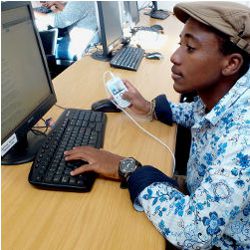
Not long ago people in richer countries thought people in low-income countries of Africa, Asia, and Latin America would use personal computers to gain access to the information society. To overcome technical, social, financial, and other hurdles, richer governments and donor agencies invested in shared access computing facilities.3 The logic was flawless: if there cannot be a personal computer in every home, a shared computer in every village will do. The global telecenter movement was born: a collection of programs providing shared access computer and Internet services to poor and remote communities.4,5
Today with the unprecedented explosion of mobile telephony, many in our field have completely written off shared access. Some even question the necessity of personal computers. If mobile phones can meet computing and connectivity needs, who needs personal computers?2,9
The first experience with a digital device in the Global South is likely to be with a mobile phone. Smartphones provide network services for those who can afford mobile data connectivity6 and the number and range of tasks possible on these phones continues to expand. Assuming this expansion is accompanied by a decline in personal computer use, the shared access model falters. However, as shown in Figure 1, suppose instead that mobile smartphone adoption stimulates demand for the personal computer in shared access settings?
Suppose mobile smartphone adoption stimulates demand for the personal computer in shared access settings?
The Technology & Social Change Group at the University of Washington Information School studied five low- and middle-income countries—Bangladesh, Brazil, Chile, Ghana, and the Philippines.7,8 Their large-scale (n=5,010) user surveys and non-user surveys (n=2,000) were accompanied by ethnographic, experimental, and other methods. They found the vast majority of current shared access personal computer users also possess mobile phones (96%), and mobile Internet access was rarely the reason why former users stopped going to shared access venues.
Half of these respondents had their first contact with computers through shared access (50%). Even more so for first use of the Internet (62%). Shared access venues were often more important for developing computer (40%) and Internet (50%) skills than school or home. They were where people could accomplish information tasks from health to education, with large majorities citing the importance of knowledgeable staff, good equipment, fast connectivity, low cost, and peer learning opportunities at shared access centers—features not readily found elsewhere.
Perhaps mobile phones and shared access venues are complements, not substitutes?
Perhaps mobile phones and shared access venues are complements, not substitutes? Research by Marion Walton of the University of Cape Town, South Africa, and Jonathan Donner of Microsoft Research India suggests so.7,8 They studied teenage users of Internet-enabled phones and libraries and cybercafés in low-income Cape Town neighborhoods. Their detailed interviews, activity/drawing probes, and task analyses of 53 teenagers and surveys of 280 teenage users found that overall, mobile phones and public access venue computers do not substitute for one another: each is used for a distinct set of activities and information behaviors, associated with different social, academic, or professional practices. These public access users had developed elaborate, fine-grained practices combining public access computers and mobile phones, taking maximum advantage of their complementary aspects. Figure 2 shows the preference to mix mobile phones and PCs. Shared access centers provide non-substitutable value for resource-constrained users, including those with “the Internet in their pocket.”
Implications
The emerging generation of people in low-resource environments uses both the mobile Internet and shared access personal computers. Home PC or tablet penetration levels equivalent to those found in the North may take decades to achieve, meaning for the near future the majority of people in developing countries will use a mobile phone for social interactions but will benefit from a shared computer to do their homework, take an online course, prepare résumés, or create business spreadsheets. Maybe such tasks could be performed through both mobile phones and shared access computers. Trading off constraints and affordances between the two appliances and contexts might allow users to leverage a shared center’s local network, the cloud, and the mobile phone. Innovation that leverages the increasing ubiquity of mobile phones will drive new uses of shared access centers in low-resource environments.
In the previous Communications Global Computing column, Michael Best called for community computers that are purpose-built for shared contexts, challenging the titular implications of the personal computer.1 By observing use patterns and identifying needs in shared access centers, solutions for the mobile phone to PC pipeline could yield tremendous benefits for the Global South.





Join the Discussion (0)
Become a Member or Sign In to Post a Comment